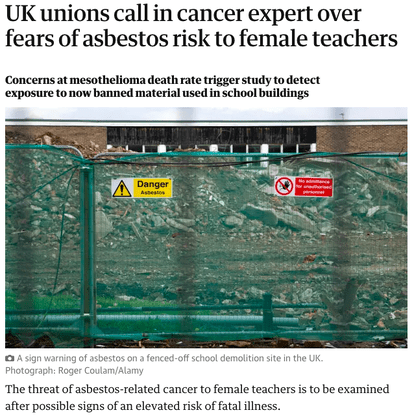It has been reported recently that UK trade unions are working with one the country's leading cancer experts over fears of asbestos risk to female teachers.
Statisticians have detected a rate of mesothelioma deaths among teachers born between 1955 and 1974 that “borders on statistical significance”.
See: UK unions call in cancer expert over fears of asbestos risk to female teachers
Debbie Hales, owner of Asbestos Limited steps away from the alarmist headline and offers some invaluable guidance - as well as common sense - for anyone worried about the potential existence of asbestos.
An Asbestos Survey removes doubt
Whilst the headline catches your attention, we must remember that things have vastly improved since the 1970’s.
Since 2004 it has been a legal requirement for the duty holder to take reasonable steps to find out if there are Asbestos Containing Materials (ACMs) in non-domestic premises. This is easily achieved by having an Asbestos Management Survey carried out. Should any ACMs be identified, then a live Asbestos Management Plan (AMP) must be created to manage the risk. This is referred to in the Guardian report, stating that most were found to have a plan for managing it, which surely should be saluted.
(Ed - for any that don’t, we are excellent at helping with this by the way 😉)
It's all about the risk
By using your live AMP, it may be that the material risk assessment within it confirms that the product is of low risk, but the priority risk score may confirm that the item is at high risk of disturbance.
For example, an Asbestos Insulation Board (AIB) panel that is in good condition in the boiler room, would give a lower priority risk than the same product next to a child’s desk. Equally, a high risk product can be managed if the priority risk score confirms it will never be touched, i.e. good condition pipe lagging in a redundant boiler room that is permanently locked.
At the point where this situation changes, due to the area being refurbished for example, then an asbestos pre-refurbishment survey would need to be carried out as part of planning the work. The findings are then added to your AMP and you manage the project using this resource, which will likely recommend removal due to the potential risk of disturbance during the planned work.
Likely to come across asbestos? Training is a requirement
Of course ideally, we wouldn’t have used asbestos at all, but had these regulations existed from the beginning, the risk would have be appropriately managed. I do agree that managing asbestos in-situ is safer than disturbing it to remove it, but like everything, it has to be appropriate.
Asbestos Awareness Training is a requirement for anyone that may come across ACMs during their work. A list of those likely to need training can be found on the HSE website Asbestos information, instruction & training.
I do describe this training as being told "you do not know enough about asbestos to continue, so you need to contact someone who does and can take the responsibility of the decision as they are better qualified to assess the risk." Ok, I am more blunt than this when chatting person to person…
If you need someone to help...
We all need to take responsibility for being aware of asbestos risk in pre-2000 premises. This way, the procedures and processes that are in place will prevent a similar headline in the future. If you need any help with managing your asbestos, or simply want us to review what you do have, please don’t hesitate to get in touch.




